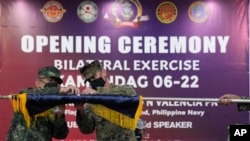The Philippines would face difficult choices during a Taiwan-China conflict that could pit its growing interest in Chinese investment against its long-term relationship with its treaty ally, the United States, according to analysts.
Manila might also find itself drawn into a conflict, whether it chooses to or not, due to the country's proximity to Taiwan, they say.
The Philippines' most populous and northern, island, Luzon, is separated from the main island of Taiwan by the 250-kilometer-wide Luzon Strait, while some Filipino and Taiwanese outlying islands are even closer. It also lies on the strategically important and disputed South China Sea, much of which is patrolled by China's maritime militia and navy.
By virtue of its geography, U.S. allies may vie for access to the Philippines' remote islands as listening stations, said Gregory Poling, director of the Southeast Asia Program and Asia Maritime Transparency Initiative at the Washington-based Center for Strategic and International Studies.
"China has radically changed the status of forces in the South China Sea, which means the U.S. and Japan don't control the southern end of the Taiwan Strait anymore. At best, we can monitor and try to interdict in the northern half, which makes the Philippines all the more important," Poling told VOA. "It's the only piece of territory close enough from which you could hypothetically both monitor and maybe even strike Chinese assets in the southern half of the Strait."
Similarly, the U.S. might seek to rotate military personnel and ships through the Philippines as part of its 1998 Visiting Forces Agreement and 2014 Enhanced Cooperation Agreement with Manila.
Philippine Ambassador to the U.S. Jose Manuel Romualdez recently said in an interview that Manila might allow the presence of U.S. troops in the Philippines during a conflict "if it is important for us, for our own security," although he also called for more dialogue between China and the United States.
U.S. forces could also use a shipyard at one of its former naval bases on the west coast of Luzon, purchased by the American private equity firm Cerberus Capital in May.
Under former Philippine President Rodrigo Duterte, Manila moved deliberately away from the United States, Taiwan's main backer, toward China, and threatened to cancel the Visiting Forces Agreement, which eases access to the country for U.S. military personnel.
In the past two years, however, "the dial was already shifting back towards greater US-Philippines military cooperation" as Duterte's six-year term came to an end, Susannah Patton director of the Southeast Asia Program at the Lowy Institute in Australia, said by email. It has continued to do so under new President Ferdinand Marcos Jr. — son of the late dictator Ferdinand Marcos -- with plans to extend the Balikatan, Salaknib, and Kamandag joint military exercises between the United States and the Philippines.
In October, the United States, in turn, approved $100 million in foreign military financing to the Philippines, on top of regular military sales.
"Compared to Duterte era, definitely the military in the Philippines feels less constrained in holding these military exercises with the U.S.," said Bob Herrera-Lim, a political and economic risk adviser with the New York consulting firm Teneo, specializing in Southeast Asia. Many Philippine elites and military leaders also "feel greater affinity for the US than China," he said.
One reason may be the Philippines' frequent run-ins with China in the South China Sea, where Beijing continues to lay claim to the disputed Spratly Islands and Scarborough Shoal, even after an international tribunal ruled in Manila's favor in 2016. The ruling, notably, has been rejected by Taipei as well.
China's maritime militia regularly harasses Philippine fishing boats and has blocked resupply missions to marines living aboard the BRP Sierra Madre, a grounded ship on a disputed South China Sea shoal.
Still, Chinese investment in three major railway projects has continued, despite political tensions, said Joshua Espeña, a resident fellow at the Manila-based think tank International Development and Security Cooperation.
The greater Philippines public also shares some distrust of the United States, its one-time colonizer, seen as having a history of abandoning allies at crucial moments, such as the Philippines in 1942, South Vietnam in 1975, and Afghanistan in 2021, Espeña said. The United States has also stayed neutral during several South China Sea crises, a point remembered within the Philippines.
In a Taiwan-China crisis, the greater public may find themselves facing a humanitarian disaster, said Espeña, as Taiwan is home to nearly 160,000 Filipinos.
"The Department of National Defense Officer-in-Charge Jose Faustino Jr. mentioned in public its " detailed contingency plan "before the Philippine Senate hearing last August [that] it anticipates a humanitarian crisis to accommodate Taiwanese, overseas Filipinos, and other nationals," Espeña said by email. "But he carefully mentioned that this contingency plan, should it need our commitment to the 1951 Mutual Defense Treaty, would have to be carefully done according to our constitutional processes."
Poling said as the United States and the Philippines continue to negotiate their military and security ties, now may be the time for Manila to gain a more equal footing with the U.S., which often treats it like a "junior partner." However, Manila may in turn find it harder to stay neutral in conflicts like Taiwan-China when it has more responsibilities toward the U.S., he said.
"In an unequal alliance, the Philippines didn't have to do anything, it just had to provide the Americans with access and the Americans provided money in exchange," Poling said. "Now, an equal alliance means if we're going to go to the mat for the Philippines, the Philippines has to go to the mat for Americans, and that's going to be a controversial thing to socialize within the Philippines."







